Consumer unit buying guide
Consumer unit buying guide
Introduction
Consumer units are the hub of every electrical installation and an electrical safety device essential to every home or business. So, it’s vital to get the right type for the job. But consumer unit types and the regulations for fitting them can change. So, we’ve put this guide together to help you get up to date with the latest information.
This consumer unit buying guide covers the basics of what a consumer unit is and the 18th edition regulations. We also look at the five types of consumer units and how they differ from distribution boards. Finally, we highlight some things to consider when installing a consumer unit.
It’s important to note that the installation of consumer units must always be carried out by a qualified electrician.
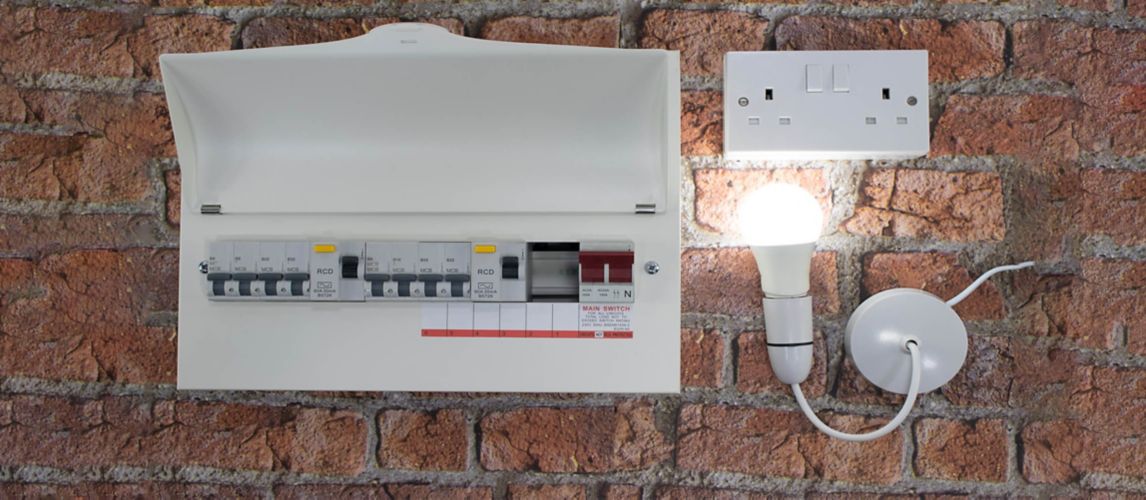
What are Consumer Units?
Consumer units (also known as fuse boxes or fuse boards) are the control centre for electricity in every home and business. They take the incoming electricity supply from outside and reroute it to multiple circuits around the building. Each circuit can be controlled separately, so the electricity supply can be isolated in one part of the property without shutting off the power to other parts.
A consumer unit is a safety requirement for every home and workplace because it protects cables and the appliances attached to them from overload to prevent fires. And it also protects people from electric shock caused by earth leakage.
There are five types of consumer units, and they can contain a combination of these four circuit protection devices:
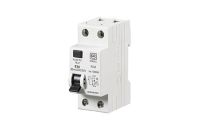
A residual current device (RCD) protects a group of circuits from residual current and earth leakage.
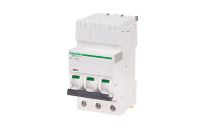
A mini circuit breaker (MCB) or fuse protects individual circuits against overload and faults.
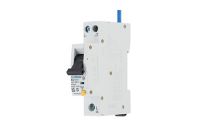
A residual current circuit breaker with overload (RCBO) combines the protection from an RCD and an MCB into one device and protects an individual circuit from residual current and overload.
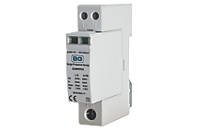
Some consumer units have a surge protection device (SPD) designed to protect against power surges. SPD consumer units are ideal for homes in areas where lightning strikes are prevalent.
Consumer units come in various sizes to support different numbers of electrical circuits and components, so you can find one to suit the property's needs. These differences are referred to as 'ways' and 'modules'. The number of ways refers to the number of circuits that can be set up within the consumer unit. Whereas modules refer to the number of spaces available for the components. Each component can take up one or two spaces. For example, the main switch, RCD and SDP each take up 2 modules, while MCBs and RCBOs use one module each.
Some consumer units are populated, which means the circuit protection devices are already fitted into the unit. And some are supplied as unpopulated, meaning there are no pre-fitted circuit protection devices. This gives more flexibility to design a consumer unit to the exact specification you need. Consumer units can also be supplied either with or without RCDs.
Types of Consumer Unit
There are five types of consumer units available. Their primary functions are all the same, but they differ in some aspects to allow for different requirements.
The five types of consumer unit are:
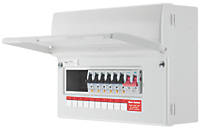
Main switch consumer unit
A main switch consumer unit is supplied with a mains on/off switch. Some come with RCDs, while others are supplied part-populated, so you can add your own circuit protection devices to suit the requirements of the property.
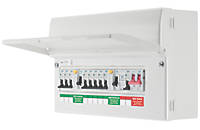
Dual RCD consumer unit
A dual RCD consumer unit is supplied with a main switch and two RCDs, allowing you to configure two banks of circuits that can be controlled separately. They are available populated with MCBs or part-populated, so you can add your own circuit protection devices to suit the requirements of the house
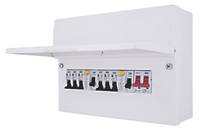
High integrity consumer unit
A high integrity consumer unit is built with three neutral bars and is supplied with a main switch and two RCDs. It also allows for two banks of MCBs and a bank of RCBOs – combining the best aspects of both the main switch and dual RCD boards. Compared to the other types of electrical consumer units, they offer total circuit separation and more protection for high-priority circuits.
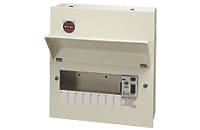
RCD incomer consumer unit
An RCD incomer consumer unit is a single RCD consumer unit with no main switch. It has no circuit separation as it can only be populated with MCBs. This means if one circuit has a fault, then the power to all circuits will be knocked out. For this reason, this type of electrical consumer unit is only used for outbuildings, such as sheds, garden offices or garages.
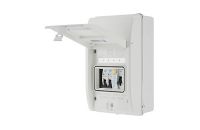
Garage consumer unit
As the name suggests, a garage consumer unit is usually used in garages and other outbuildings, such as sheds and garden offices. The term is given to any consumer unit that is typically 4-ways or less because they’re used in places where only a few circuits are needed.
Other Types of Consumer Units
Each type of consumer unit above can come in up to four different designs as follows:
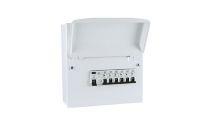
Standard ‘amendment 3’ consumer unit
This is the most common way all consumer units are supplied – as a standard surface-mounted, metal unit. They feature a front lid that’s hinged at the top so that it automatically closes when the unit isn’t being worked on.

Duplex consumer unit
This is a consumer unit that has its circuits arranged over two rows. However, this doesn’t always mean that there are two banks of circuits. Most Duplex consumer units are high integrity consumer units used in larger buildings. But they can also be dual RCD or main switch consumer units.
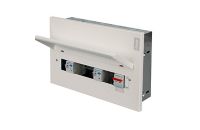
Flush consumer unit
This type of consumer unit is the same as a standard ‘amendment 3’ consumer unit, except it’s recessed in a wall rather than surface-mounted. A flush consumer unit is usually chosen purely for aesthetic reasons.
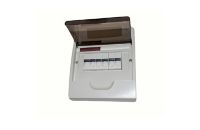
IP rated consumer unit
This is a waterproof consumer unit used in wet areas such as pools and spas. ‘IP’ stands for water ingress. Any electrical item designed for wet areas has an IP rating to indicate how waterproof it is.
18th Edition Consumer Unit Regulations
The 18th edition consumer unit regulations apply to the design, erection and verification of all electrical installations, which must comply with the latest update BS 7671:2018+A2:2022. It applies to new installations and alterations to existing installations, and came into effect on 28th March 2022.
In general, 18th edition consumer unit requirements state all electrical circuits must be protected from:
- Overload – which can result in fires
- Residual current leakage – which can result in electric shocks
Consumer units in domestic households must also be made from a non-combustible material so that any fire within the unit will be contained. All new consumer units are made to meet these standards.
The 18th edition consumer unit requirements supersede 17th edition wiring regulations. So, if you haven’t installed a new consumer unit for a while, here’s a summary of the changes:
- Transient overvoltage protection: a risk assessment must be carried out to determine if a property is at risk of transient overvoltage from lightning strikes or switching loads. Surge protection must be provided if there is a risk that could cause serious injury or loss of human life.
- Protection against thermal effects: to protect against fire, burns and overheating caused by arc faults, in some circumstances, the regulations recommend that Arc Fault Detection Devices (AFDDs) are installed in a consumer unit.
Fire cable and fire-related cable clips: all cable support systems must be constructed from appropriate materials to protect against premature collapse in a fire. This now covers all cable and cable management in a building – not just escape routes. So, this will apply if you are changing a consumer unit as part of a rewiring project. To learn more about rewiring, read our professional's guide to rewiring a house.
- RCD protection: all socket outlets with a rated current not exceeding 32A and lighting circuits within homes must have RCD protection. This previously only applied to 20A sockets, and then only if a risk assessment had been carried out and it was deemed necessary. However, that’s no longer applicable.
For more detailed information about these changes, see our 18th edition wiring regulations guide.
It’s important to note that consumer units installed before 1st January 2019, in accordance with earlier editions of the regulations, may not comply in every aspect to the 18th edition regulations. However, there is no requirement to replace them if they are safe and don’t have any defects.
What is the Difference Between a Consumer Unit and a Distribution Board?
The terms ‘consumer unit’ and ‘distribution board’ are often used interchangeably, but they are not always the same thing. A consumer unit is a type of distribution board, but not all distribution boards are consumer units.
A consumer unit is the type of panelboards seen in most UK homes, recognisable as a metal or plastic box containing breaker switches. But a distribution board is typically used in commercial buildings. It works in a similar way to a consumer unit in a home but on a larger scale. Its job is to safely deliver the right electricity voltage to each area of the building. Often, local regulations dictate how these boards are configured, and for that reason, distribution boards are fully customisable.
Large industrial, public and commercial buildings and some homes may also use a 3 phase distribution board. They’re used to distribute power to individual consumer units or circuits within the building, allowing each circuit to draw power directly from the breakers while isolating them without disrupting the rest of the power supply.
Things to Consider When Installing a Consumer Unit
Choosing a suitable consumer unit for a job will depend on several factors. So, here are some important things to consider about the installation before you decide which one to buy:
1. How many consumer units do you need? You’ll only need one consumer unit for a home in most cases. However, there are some scenarios where you may need to fit a second consumer unit. For example, when adding electrical circuits to an extension in an existing building. The current consumer unit can only provide a certain amount of wattage. If the new circuit is going to exceed that wattage, then a second consumer unit will need to be installed. You may also want to install a second consumer unit if you’re powering an outbuilding, such as a garage or shed.
2. Where is the consumer unit going, and what is it used for?
Knowing where the consumer unit needs to be installed and what it's being used for will help you decide which type to get. For example, if it's going in a wet area to be used for a pool pump, you'll need an IP rated consumer unit. You'll need a garage consumer unit if it's for an outbuilding. And, if it's for the main house, check what space is available. If the space is tight, a flush consumer unit may fit better than a standard 'amendment 3' option
3. How many ways and modules are needed? Plan how many banks of circuits you’ll need, which will tell you how many ‘ways’ you require. Then plan the number of individual circuits to give you the number of modules. But it’s always worth allowing for extra in case any changes or additions are needed to the circuit layout in the future.
4. Which circuits require special consideration? Before buying a consumer unit or setting up the different circuits, check with the homeowners to determine which circuits are a high priority for them, as these circuits will require special consideration. Of course, smoke detectors or security alarms and cameras should always be considered a high priority. But the homeowners may also have a hair salon run from home requiring electricity, or a home office workstation. Putting these on a separate circuit means their power won't get knocked out if something else goes.
